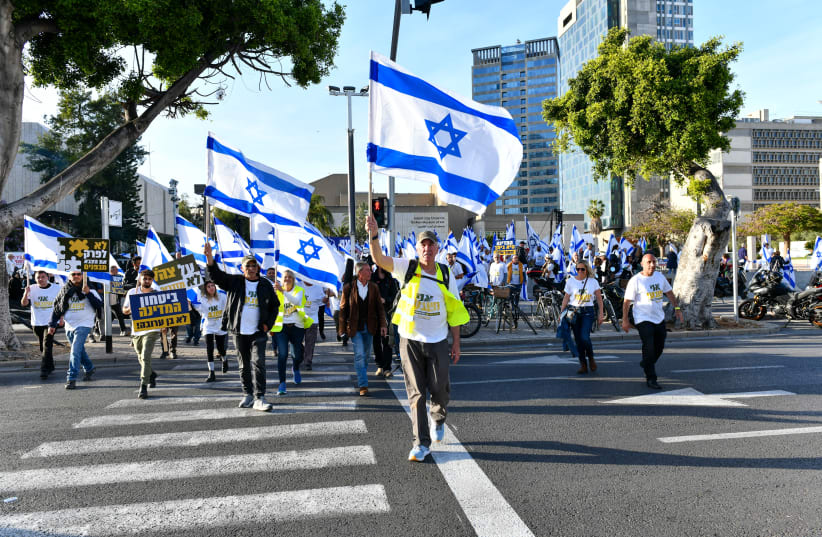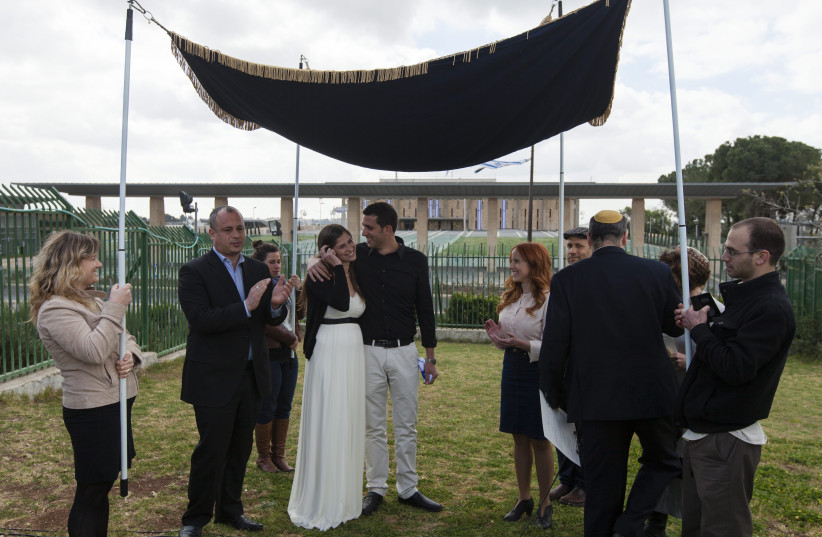The public debate surrounding the “grandchild clause” of the Law of Return has sparked a flurry of articles in both the web and religious press, discussing the rates of assimilation and the assimilation problem in Israel. As a researcher of the history of Jewish identity in the Diaspora, particularly in Spain and Sephardi communities, it is important to emphasize that intermarriage between Jews and those who are not Jewish according to Halacha is a phenomenon that is different than assimilation.
Assimilation is not a process in which one group marries another, rather it is a process in which a group or part of it loses its identity and is absorbed into another group (according to the Hebrew word hitbolilut in the Ben-Yehuda Dictionary).
Simple calculation is enough to understand that intermarriage in the Diaspora does not reduce the number of Jews according to Halacha – assuming the same number of Jewish men and women marry non-Jews and each woman has two children: a son and a daughter.
For example, two siblings, a man and a woman, in the Diaspora marry through intermarriage. The man’s children are not Jewish according to Halacha, and conversely, the woman’s children are Jewish. Even if these children, a man and a woman, marry gentiles, the woman’s children are Jewish according to Halacha and the man’s children are not – this process has been going on for hundreds of years. In the end, the percentage of Jews according to Halacha within the population is the same as the percentage of Jews at the beginning of the process.
Despite this, after three or four generations, even those who are Jewish according to Halacha have forgotten they had Jewish grandmothers. They are not considered by themselves and by the environment as Jews – they have assimilated. This assimilation is detrimental to whole communities in the Diaspora.
There is no doubt that in Spain and Portugal (and in some former colonies in America) there are whole percentages of the population that are Jews according to Halacha (many millions of people) assuming that their grandmother’s grandmother’s grandmother etc. was Jewish. Almost all these people are unaware of this family connection and have no Jewish identity – they have assimilated, despite being Jewish according to Halacha.
Jewish identity is a multifaceted and intricate issue, beyond the halachic question of whether an individual is considered Jewish. There are individuals who are Jewish according to Halacha but do not identify as such, and there are numerous people who are not Jewish according to Halacha but still identify in some way with Judaism. These individuals can be referred to as Jews on the spectrum.
The diaspora today
In the Diaspora today, particularly in communities that experienced intense secular pressure to abandon their Jewish identity, such as in Eastern Europe, these Jews on the spectrum constitute a larger group than the local Jewish communities, particularly among the younger generations.
When these people choose to come to Israel, they choose to identify with the Jewish aspect of their multifaceted identity. Many, particularly the young and educated, had the option to migrate to Germany, the United States and other Western countries.
Most of them chose to come here to reestablish a connection with the Israeli people and the Jewish identity within them, despite the fact that a significant portion of them are not Jewish according to Halacha.
This group does not possess a distinct identity; rather, they intermarry within the majority Jewish population. Men who marry Jewish women and have children with them are effectively assimilated back into Judaism. Within a few generations, it is likely that the memory of a non-Jewish ancestor will have been forgotten.
When women who are not Jewish according to Halacha marry Jewish men, the disparity between the individual’s identity and the halachic reality can be passed on to the next generation.
To maintain the Jewish identity of the Israeli population, halachic authorities should provide a solution to this problem. Rabbinic figures have taken up the challenge of finding a solution, despite the criticism from other halachic authorities. Because I am not an expert in Halacha, I will not comment on this issue.
It is important to note that the current conversion situation is not succeeding in keeping up with the large-scale emigration of Jews on the spectrum. It is succeeding in almost completely preventing a natural increase of this population in the country.
According to the data of the Central Bureau of Statistics, the population defined as “others” has the lowest natural increase rate and it is continually decreasing. (It dropped below 10 births per 1,000 population last year – slightly more than half the birth rate of the Jewish population.)
The reason for this is that most of the converts are young women, and thus most of the children of those who came as non-Jews according to Halacha are born here as Jews, as are all the children of the men who marry Jewish women and a significant portion of the children of the women due to conversion.
With the conversion of children and efforts to convert people who will be traditional after their conversion, it is very likely that this situation can improve and allow the return of the descendants of the assimilated Jews who decide to make aliyah to Judaism according to Halacha.
A noteworthy comparison between the situation in Spain at the end of the Middle Ages and the beginning of the modern time and the situation in Israel today is that in Spain, one of the primary factors that sustained the distinct identity of the conversos (Jews who had converted to Christianity and their descendants) was the hostility of the Christian population, which was expressed through the laws of limpieza de sangre, the writing of genealogical books, the prohibition of intermarriage with the conversos and the establishment of the inquisition, which maintained those laws and books until the beginning of the 19th century.
Most of the Jews who are immigrating now seek to be part of the Jewish people, to emphasize their Jewish identity and “rectify” the intermarriage of their ancestors. A welcoming attitude and conversion can bring them back to the Jewish people and even bring them closer to the observance of Torah and mitzvot.
In contrast, hostility from the rabbinical establishment and the politicians of the religious party can lead to the creation of a distinct identity, like that of the conversos in Spain, which could leave the problem unresolved for many generations.
This is a crucial period in which we must decide: should we accept the immigrants who are not Jewish according to Halacha? Or will our hostility cause them and their descendants to develop a separate identity that is not only Jewish?
Many in the religious and traditional population of Israel view intermarriage with a foreign spouse as a renunciation of one’s Jewish identity. Consequently, they do not believe that efforts should be made to bring the children of such unions back into the Jewish fold.
Those who have grown up in Israel or in well-established religious communities abroad may not be aware of the difficulty of maintaining a Jewish identity in communities that are not religiously well-established.
In the past, due to rampant antisemitism and the lack of organized rabbinic establishments, there was often no real possibility of converting the non-Jewish spouse to Judaism (unlike in the West) or of establishing Jewish communities and institutions. Many men who were deeply attached to their Judaism and were forced to live without an organized Jewish framework, married a non-Jewish spouse and did their utmost to pass on their Jewish identity to their children. Some of the children identified with their parents’ Judaism and passed it on to their descendants, who now seek to make aliyah.
Those who make aliyah today under the grandchild clause are not strangers invading our land, but rather our brothers and sisters attempting to return home. We should not turn them away, rather we should strive to welcome them and assist them in reconnecting with their people and their heritage.
The writer is a professor of Jewish thought at Ben-Gurion University.

